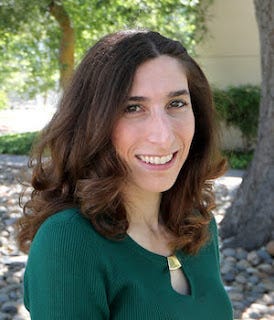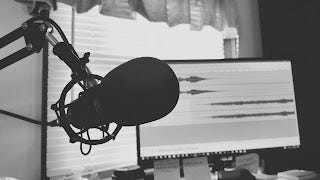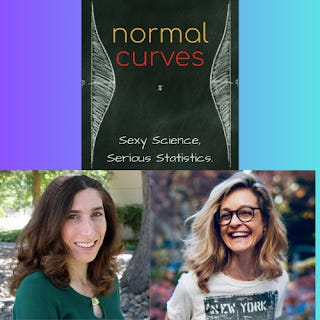Podcaster Profiles: Two Professors, A Lot Of Numbers, & Countless Fun!
Who says Statistics can't be fun!
Imagine sitting in a room crafting a concept for a new podcast. After hours of brainstorming, lousy coffee, flaky croissants, and short tempers, the group hits upon an idea they can move forward with.
The group decides to “start a podcast with two college professors who are statistics nerds and talk a lot about dissecting data.”
They bring their idea to the boss, who looks like the Community Chest guy in Monopoly. The boss barks, “Are you kidding me? This will never work. It’ll put people to sleep.”
Then you listen to the first episode of Normal Curves and realize how wrong the boss was — again! In today’s Podcaster Profiles, we will talk with the hosts of Normal Curves and find out how two classroom geeks can “ace the test for podcast excellence.”
Normal Curves is a podcast about sexy science & serious statistics. The marketing pitch is a good one: “Ever try to make sense of a scientific study and the numbers behind it? Listen in to a lively conversation between two stats-savvy friends who break it all down with humor and clarity. Professors Regina Nuzzo and Kristin Sainani discuss papers like a journal club does — except with more fun, less jargon, and some irreverent, PG-13 content sprinkled in. Join Kristin and Regina as they dissect the data, challenge the claims, and arm you with tools to assess scientific studies on your own.”
We will discuss the show's essence, but today we will focus on our two intrepid hosts.
Kristin Cobb Sainani is a Professor at Stanford University and a Freelance Science Writer. Kristin grew up in New England. She is a Stanford professor and science journalist who brings statistics and scientific writing to students and audiences worldwide. She teaches the popular Coursera course Writing in the Sciences, available in 22 languages, and offers an online medical statistics certificate program through Stanford Online.
Kristin works as a statistician on sports medicine projects. She serves as a statistical or associate editor for academic journals, including Medicine & Science in Sports & Exercise, Sports Medicine, and The American Journal of Sports Medicine.
Kristin has also written extensively about health, science, and statistics for diverse audiences. She authored a health column for Allure magazine, a beauty magazine, for ten years and authored a statistics column, along with co-host Regina Nuzzo, for the journal Physical Medicine & Rehabilitation for over a decade. In 2018, she received the Biosciences Award for Excellence in Graduate Teaching at Stanford University. Known for her statistical sleuthing and ability to cut through academic jargon, she champions sound statistics and clear language in science.
Regina Nuzzo is a Professor at Gallaudet University and Freelance Science Writer. She grew up in Florida. Regina is an award-winning science journalist and Gallaudet University professor who talks to audiences worldwide about communicating statistics creatively. She’s written for Nature, New York Times, Reader’s Digest, Scientific American, New Scientist, Science News, and ESPN the Magazine, including a column about the science of sex, dating, and relationships for the Los Angeles Times.
Regina’s feature article on p-values in Nature earned the American Statistical Association’s 2014 Excellence in Statistical Reporting Award. Along with co-host Kristin Sainani, she wrote a statistics column for the journal Physical Medicine & Rehabilitation for several years, and she formerly served as a writer for the Proceedings of the National Academy of Sciences and the American Statistical Association.
Since 2022, Regina has also been a summer Lecturer at Stanford University, where she and Kristin teach a statistics course for clinical informatics management graduate students. In her lectures and teaching, Regina often incorporates sex-science examples to keep her audiences awake, and professes no shame in doing so.
We asked both of them why they became professors.
Kristin says: “A professor has a good mix of jobs–I get to play with data, solve probability problems, teach, and write. My dream job would be a professional marathoner or a traveling science writer. I dabbled in both, but neither was terribly practical.”
Regina has a different take on it: “When I was 14, I started a little side gig tutoring other students at my school, and I tutored math all through college. I liked finding ways to engage with students who hated math. And, side benefit — I actually understood a thing better when I needed to explain it. So, eventually, being a professor seemed like a natural fit. When I first started college, I wanted to be an engineer. Then, in grad school, my backup plan was to open a used bookstore where I could read all day. After my postdoc, I went to a graduate journalism program, and then I thought I’d be a science journalist while traveling the world. But I missed teaching. I went back to academia to see if I could have a dual teaching and writing career.”
We then asked how they ended up at their respective universities.
Kristin shares: “I was planning to get out of academia after my PhD. I studied science writing at the amazing UC Santa Cruz Science Communication Program, and was just starting out as a science journalist. But through happenstance, I found myself back in my old department at Stanford. A casual ‘Can you teach one class for us?’ eventually turned into a full-time job. Turns out, the skills you learn as a science writer–for how to make technical material accessible and engaging–come in surprisingly handy when teaching math to doctors.”
Regina explains: “After the UC Santa Cruz Science Communication program, I had a job writing about science for the National Academy of Sciences in Washington, DC. But I missed teaching. That’s when I saw a faculty job posting at Gallaudet University. Gallaudet is unique in the world — it’s the only university designed for deaf and hard-of-hearing students, where everything is communicated in sign language. Although I was born half-deaf, I wasn’t fluent in American Sign Language, and I wasn’t part of the Deaf community.
But I was intrigued, so when they offered me a tenure-track position in the math department, I accepted. Then a few years ago, Kristin invited me to co-develop and co-teach a summer statistics course at Stanford School of Medicine, so now I get that experience too.”
Regina adds: “As a side note, becoming fluent in ASL and teaching statistics in ASL has really changed me as a communicator and a teacher, for the better.”
Then we asked: “Since you both have extensive writing experience, why not a blog, website, or Substack instead of a podcast?”
Kristin explains: “Regina and I have been co-teaching a statistics course at Stanford since 2022. For that course, we created ‘podcast-style’ video lectures where we delivered the lessons through conversation and case studies. Our students told us that our lectures were better than Netflix and urged us to make a real podcast. We did briefly entertain writing a statistics book together, but the podcast idea seemed more fun.
Regina adds: “We thought about all of these! And a book, too. Our students were the first to suggest the podcast. For the Stanford statistics course that we co-teach, we recorded lectures in what we call ‘video podcast-style.’ Instead of just one person lecturing to the camera and then switching off to the other person doing the same, we decided to teach through conversations with each other, centered around stories and real-life case studies. Our students loved them. They told us to make a podcast in the same style because they wanted to continue learning even after they left our class. Also, I like doing podcasts because Kristin and I can interact with each other. This makes it more fun for us. We’re genuinely good friends and always have interesting conversations when we get together — both nerding out and making each other laugh. I think it makes it more engaging for our audience, too. It’s hard to capture that kind of banter in a blog! Normal Curves is just right for our conversations.”
The real question is: Can these two college professors be engaging podcast co-hosts? The answer is an unqualified yes. Perhaps it is the years of lecturing students, but the co-hosts are comfortable in front of a mic.
Dr. Kristin and Dr. Regina live up to their marketing promise and make the show fun, funny, and a painless way to learn more about data and statistics.
The show began in February with the requisite trailer and a short, introductory episode of 13 minutes about the show and themselves.
Their first episode was promising and entertaining. The episode pulled the curtain back on sweaty t-shirt dating parties, sex pheromone dating sites, and choosing your dating partner by sniffing them up. Then, the two professors asked if these are wacko fringe fads or evidence-based mating strategies? And what does your armpit stain have to do with your kids’ immune systems, or hormonal contraceptive pills, or divorce rates?
In this episode, Dr. Kristin and Dr. Regina reach back into the 1990s and revisit the scientific paper that started it all: The Sweaty T-Shirt Study. They bring a sharp eye and open mind, critically examining the study and following the line of research to today. Along the way, they encounter interesting statistical topics — including correlated observations, within-person study design, and bar-chart blasphemy — with a short, surprising detour into Neanderthal sex.
It was an enjoyable show; plus, I know something about correlated observations. In the third episode, the professors chat about how wearing red drives men wild with lust — or so says scientific research on color’s role in human mating. But can a simple color swap really boost a woman’s hotness score? In this episode, the professors delve into the evidence behind the Red Dress Effect, from a controversial first study in college men to what the latest research says about whom this trick might work for (and who it might not).
In a recent episode, the “Professors” control their disgust and discuss hookworms and why some people intentionally infect themselves with these repulsive creatures. Along the way, listeners learn about block randomization, nonparametric hypothesis tests, and, most importantly, worm sex.
During this first season, the co-hosts encounter red monkey butts, old-Internet websites, the Winner’s Curse in scientific research, adversarial collaborations, and why size (ahem, sample size) really does matter.
Like almost all independent podcasters, Kristin and Regina find aspects of podcasts challenging.
Kristin confesses her disdain for the tech: “Who knew it could be so time-consuming? When you listen to podcasts, it just sounds like a few people chatting for an hour. But turns out it’s a lot more intricate than that behind the scenes. I have a love-hate relationship with technology, and I’m currently in full ‘yelling-at-the-software-because-it-won’t-do-the-thing-I-want mode.’”
Regina shares the difficulty of making content accessible to listeners: “How do we talk about sophisticated statistical concepts in a way that makes sense for listeners? We end up coming up with a lot of off-the-wall analogies, metaphors, and examples. Why is statistical adjustment like Botox? What body part measurements can we use to illustrate the normal distribution? We spend time bouncing ideas off each other to get it right.”
Regina added: “I didn’t realize how much time it takes! And also, how hard it is to remember to hit ‘record.’ Seriously, are we the only ones who have had a great conversation only to realize we never actually recorded anything?”
Then we asked about the challenge they have in the podcast. How can they help untrained people use statistical analysis to detect bullshit?
Kristin responds: “You don’t need to be a statistician to detect bad information and bad statistics. A little common sense and a few elementary math skills go a long way. In a recent episode, the tipoff of some bad statistics was that you can’t have 76% of 40 people. You can have 75% (30/40), but you can’t have 76% (30.4/40) because that would involve sawing off body parts. Our podcast is going to teach a lot of basic skills like this for spotting BS.”
Regina gives us a few questions to ask to detect BS. “You don’t always need a lot of statistical training to start to root out problems. Part of the statisticians’ toolbox is just asking questions with an open mind. That’s what we’re trying to model on Normal Curves. Some of the best questions are common-sense ones, like, ‘Who exactly participated in this study?’ ‘What else could explain these results?’ ‘That number seems oddly high — where did it come from?’ In one episode, we discussed a statistic that up to 100% of European people were vitamin D deficient. That is a weird number. Where did it come from? Turns out it was from a small study of Italians 98 to 105 years old. That’s where you go, ‘come on, that’s just misleading.’ And you don’t need stats training for that.”
We asked the co-hosts if we would learn correlation coefficient, maximum likelihood estimate, and Bayesian inference on the podcast.
Kristin says enthusiastically, “I cannot wait to do an episode on maximum likelihood estimation. That was my favorite topic in grad school.”
Regina chimes in: “You will definitely learn all of those things! I love Bayesian inference. When we read through the papers for an episode, we have to narrow down which statistical tools are the most relevant to cover. There’s so much we could discuss for each episode. We want to talk about all the cool things, right now. But we need to pace ourselves. It’s hard. In raw terms, can learning the basics of statistical science, help us detect “bullshit?”
Kristin explains: “Statistics isn’t just a collection of formulas. It’s a way of thinking. In this podcast, we will be teaching the tools people need to question data, evaluate claims, and recognize when numbers are being used to mislead.
Regina concurs: “Absolutely! Statistical science is really a way of thinking about the world. It helps us make conclusions from incomplete and messy information, wrap our heads around uncertainty and probability, get a handle on variability, understand hidden relationships, and ask all the right questions. Statisticians make good bullshit detectors.
When we mentioned that it sounds like they’re having fun on the podcast, the “profs” couldn’t wait to answer!
Kristin chortles: “Yes, we are having fun! What could be more fun than chatting about statistics and boys?
Regina chuckles: “Not an illusion! Actual fun! With each episode, we’re learning cool things — like why hookworms can be healthy, or how chocolate cake affects your face wrinkles, or how body odor attraction works. Plus, we amuse ourselves. Sometimes we end up laughing so much we can’t even get a word out.”
Finally, our curiosity got the better of us, and we asked what highly esteemed college professors do for fun.
Kristin says: “A lot of my free time revolves around exercise. I run a lot and work out in my home gym, which is basically a fitness museum–complete with a Nordic track skate machine from the 80s! I also spend a lot of time at my daughter’s swim practices and meets. I am an expert lap counter as my daughter’s favorite event is the mile, which is 66 laps. And, of course, making the podcast with Regina has been a blast.”
Regina: Besides podcasting with Kristin 24/7, (she laughs), I’ve always got a few books in progress — good novels that get me out of my own head. Recently, a friend introduced me to birding. Before I got my cochlear implant ten years ago, I’d never heard birds. Now I’m training my brain to hear them with fancy spectrogram apps. And I’m addicted to the Supernatural fitness app on my virtual reality headset. I work up a huge sweat in my living room boxing to 80s hits and doing disco dance moves. It’s a good thing no one can see me.”
Independent podcasters are diverse, ranging from bakers to ball players, and morticians to mannequin dressers. That diversity is what makes indie podcasts so inviting and engaging. By contrast, network-supported shows offer listeners the monotony of celebrities with their divorced-from-reality lives and self-absorbed hissing.
After reading about these two college professors who couple intelligence with insouciance, it is a statistical probability that you will listen to Normal Curves.
I highly recommend Normal Curves. The show tweaks the usual informational podcast format, adding science with a beaker full of fun and frictionless learning about statistics.












